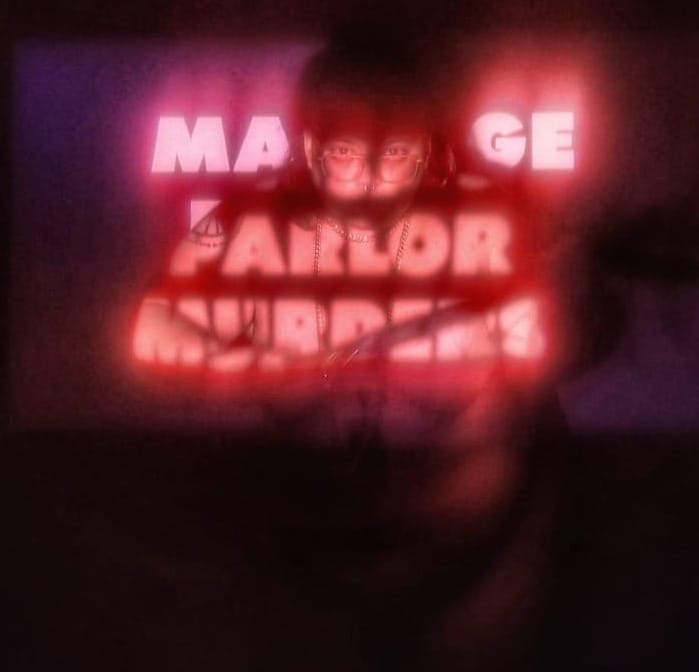LONGLEGS Was Transphobic Whether You Liked It Or Not
I find myself constantly wondering if writers and directors are mining queer experiences for the spooky vibes on purpose, or if people are so used to queerness being monstrous that they invoke us as boogeymen without thinking about it.

In the final moments of LONGLEGS, we experience the surprise resurrection of a supernaturally-powered killer. The post-denouement swipe of a dead claw is a hallmark of the genre, and one that is typically offered to the viewer outside of the reality of the film itself. It’s Carrie’s gory hands shooting out of her grave towards her grieving friend, Freddy snatching Nancy's mom back through the porch window; a reminder that the primal evil which manifested itself in a simple form for this chapter of the story isn’t actually dead. There’s still something to be scared of, even if this iteration has found its resolution.
Longlegs’s final resurrection moment feels pathetic in comparison to his monstrous brethren. He reclines in a holding cell, his hair a troll doll tangle, his full glam beat of powdery makeup flaking from his face as he giggles and kisses the air. “Hail Satan,” he coos, before the film slams us into the credits, his chapter complete. And within the theater at least, it is.
Outside of the theater, we have been arguing about whether LONGLEGS is transphobic for several months. It has become my least favorite kind of conversation about queer representation: Is It Problematic? A game show where nobody wins, starring a handful of people earnestly twisting themselves in pretzels to give millionaires the benefit of the doubt.
Meanwhile, when I click a random post about the movie on Instagram, I can find a dazzling bouquet of comments from people who had no difficulty making jokes about Longlegs looking like a woman:

If it is easy for a rando on the internet to pick up on the vibe here, I’m not sure why a lot of earnest film critics are struggling to see it.
So here, let me simplify things. If the question is about whether creating a horror villain that is a male serial killer of Christian children with an exaggeratedly grotesque feminine appearance and prominent queer-coded aesthetics is transphobic?
The answer is yes.
It’s also a profoundly uninteresting question with an obvious answer. What I am interested in is why Longlegs is transphobic. I do not believe the film was made from a place of malice towards trans folks, but it is the predictable product of a society that is terrified of trans bodies.
As film historians Caden Mark Gardner and Willow Catelyn Maclay note in Corpses Fools and Monsters, there is a rich history of gender non-conformity being used as a shorthand for villany in horror movies. It’s a practice that has its roots in the early queer coding of horror, but the film PSYCHO solidified the trope by being a mainstream hit with a gender-bent slasher played sympathetically by Anthony Perkins.
In PSYCHO, Norman’s over-identification with Norma takes the blame for his murderous tendencies, an echo of the then-contemporary belief that queerness was an antisocial pathology caused by an overbearing mother. Not everybody who watched PSYCHO consciously made that connection when they saw Norman in a wig and his mother’s Sunday best, but they did not need to do that in order for the horror to work. They were already trained to see visible queerness as a shorthand for a transgressive criminal motivation. A good filmmaker was able to exploit that shorthand to create an iconic horror villain, one ironically played by a beloved queer actor that a lot of queer folks love.
So! Is It Problematic? Let’s try and find a satisfying answer.
- Was Alfred Hitchcock homophobic? Maybe! We’re still arguing about it.
- Did PSYCHO play with then-contemporary ideas about queer people to create a pathology that motivated Norman Bates? Unquestionably.
- Was Norman Bates meant as an intentionally-portrayed queer panic figure? Probably not.
- …but did it land that way with the public anyway, and inspire a lot of other problematic portrayals of queer and trans folks? YEP.
Because the horror of transness and queerness is so often conflated with the horror of monstrosity in popular media, watching horror movies as a trans person can feel fraught. I find myself constantly wondering if writers and directors are mining queer experiences for the spooky vibes on purpose, or if people are so used to queerness being monstrous that they invoke us as boogeymen without thinking about it.
For example, I have been struggling to finish this piece because I cannot come to a conclusion about Longlegs’s appearance being intentionally transphobic. The makeup and prosthetics that inspired the transphobic comments about Longlegs on Instagram were reportedly inspired by real-life plastic surgery techniques pioneered on the West Coast in the 70s and 80s. Longlegs spent lots of time with said plastic surgeons making himself beautiful to please the devil, leading to his final appearance in his titular film.
Given what I know about trans healthcare and history in the United States, I became curious about a potential link to facial feminization surgery (FFS). FFS was pioneered in the 70s and 80s by plastic surgeons on the West Coast when serving trans patients created a new market for them. Given the time period in which the techniques were perfected and the specialized niche of plastic surgery these techniques occupy, it seems nearly impossible to me that there would be no overlap.
Now, can I prove that Longlegs’s appearance is actually based on the surgical techniques that became FFS? No, that should be handled by someone smarter than me. Feel free to look into it and draw your own conclusions.
Do I think that the portrayal of Longlegs was intentionally transphobic because I caught something the filmmakers might have missed? Also no! I know what FFS is because the people I love have gotten it or are saving up for it. I am also a person who knows enough about horror movies and trans stuff to connect the dots between a weird interview with a makeup artist and the history of transgender health care in the United States. I don’t expect everyone else to know these things. That’s why I write these essays.
But do you want me to pretend that those Instagram comments up there don’t exist? Do you want me to pretend that visible gender-non-conforming queerness has not been used as a cultural shorthand for danger since the days of the Hays Code? Do I really have to act like we have not spent the last half-century arguing about Buffalo Bill, DRESSED TO KILL and the cunty Leatherface from TEXAS CHAINSAW MASSACRE: THE NEXT GENERATION?
Art made in a transphobic culture will reflect those values, even inadvertently. The background radiation of transphobia can contaminate any subject. Instead of pretending it does not, why can't we call it what it is and ask why?
And yes, I know that Oz Perkins himself has also said the film is not meant to be transphobic. That’s great! I think it’s nice when a cis person knows they are not supposed to be a transphobe, and I believe he is sincere. But saying “transphobia is bad” is not the same thing as thoughtfully unpacking the unintended impact of the art you have created. I do not think that Perkins set out to make a transphobic film, but I think that the focus on absolving him does him a disservice as an artist.
To be honest, I don’t really care if people agree with me that LONGLEGS is a transphobic film, even if one of the people who disagrees with me is the director. I don’t even care if other trans folks loved it. Queerphobia does not make a film unwatchable for all queer folks. A lot of us resonate with gory fucked-up stuff, and there’s a reason that trans folks sell an anti-TERF shirt featuring Angela from SLEEPAWAY CAMP. Norman Bates was one of my first queer monsters, and he still has a soft spot in my heart. Our monstrous family members can be reclaimed through the empathy we have for them, or the gestures of power they represent for us.
Other queers can reclaim Longlegs, but I’ll pass. My main beef with LONGLEGS isn't transphobia. It’s that I wasted a date with a pretty girl on a pretentious horror movie that insulted us both to our faces. It was boring and convoluted and stupid, and Longlegs was a wet fart of a villian in Wet ‘n Wild eyeshadow. I have sought myself in the faces of a thousand monsters, but I can't forgive a killer for failing to serve cunt.
Anyway. LONGLEGS was transphobic! It would remain transphobic regardless of the pure intentions and ignorance of the people involved, and it will continue to be transphobic no matter how many words anybody writes about it in either direction. I do not care who disagrees with me, or what vertical they write for. Please do not waste my time by writing me bitchy emails or arguing with me on social media about this unless you want me to respond with the most enthusiastic fart noise my lips can produce.
Whatever that fart would be, it would still be more fun to experience than the end of LONGLEGS. Hail Satan, indeed.
(eternal thank you to editor extraordinaire lillian boyd, whose feedback made this piece what it needed to be <3)
